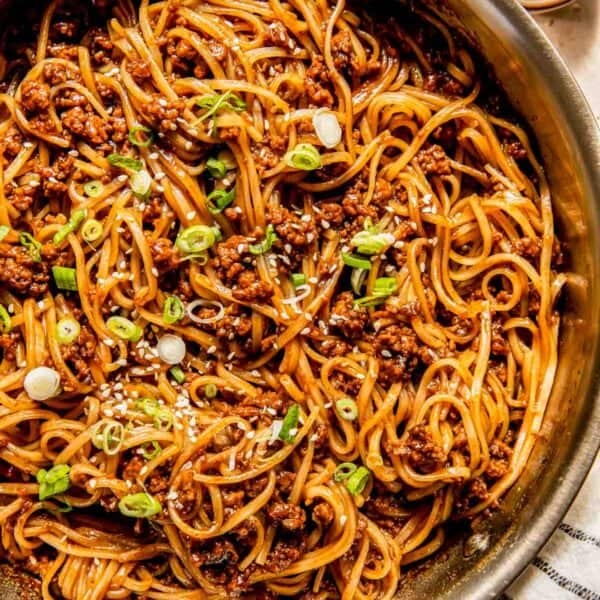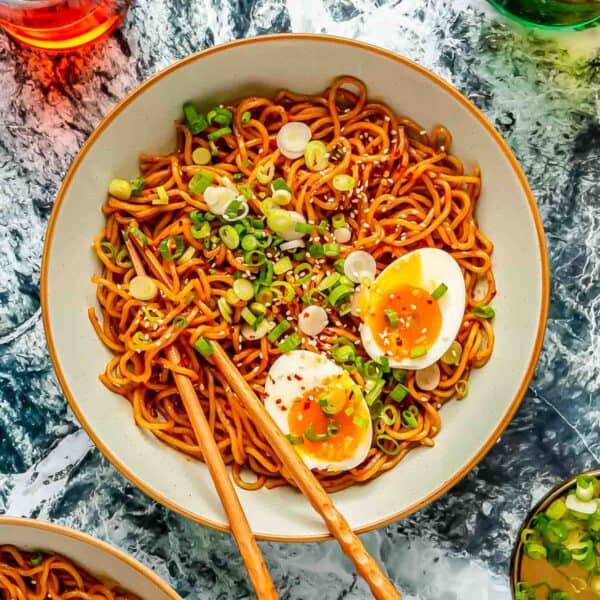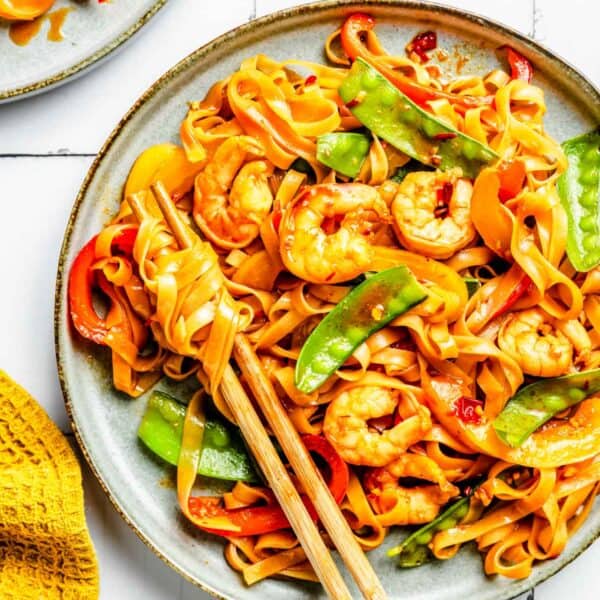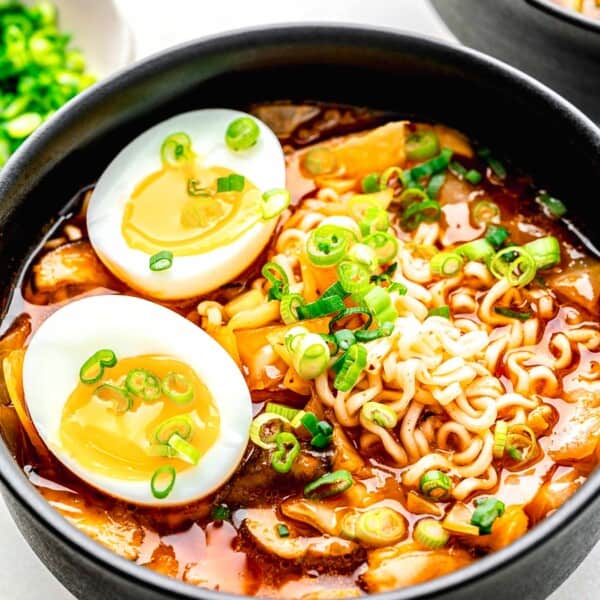This post may contain affiliate links. Please read our disclosure policy.
Indulge in a symphony of flavors and textures with this shrimp chow mein. Juicy shrimp, stir-fried veggies, and ever so slightly crisp noodles are lightly coated in a savory-sweet sauce that will knock your socks off. Forget takeout! Make this classic at home.
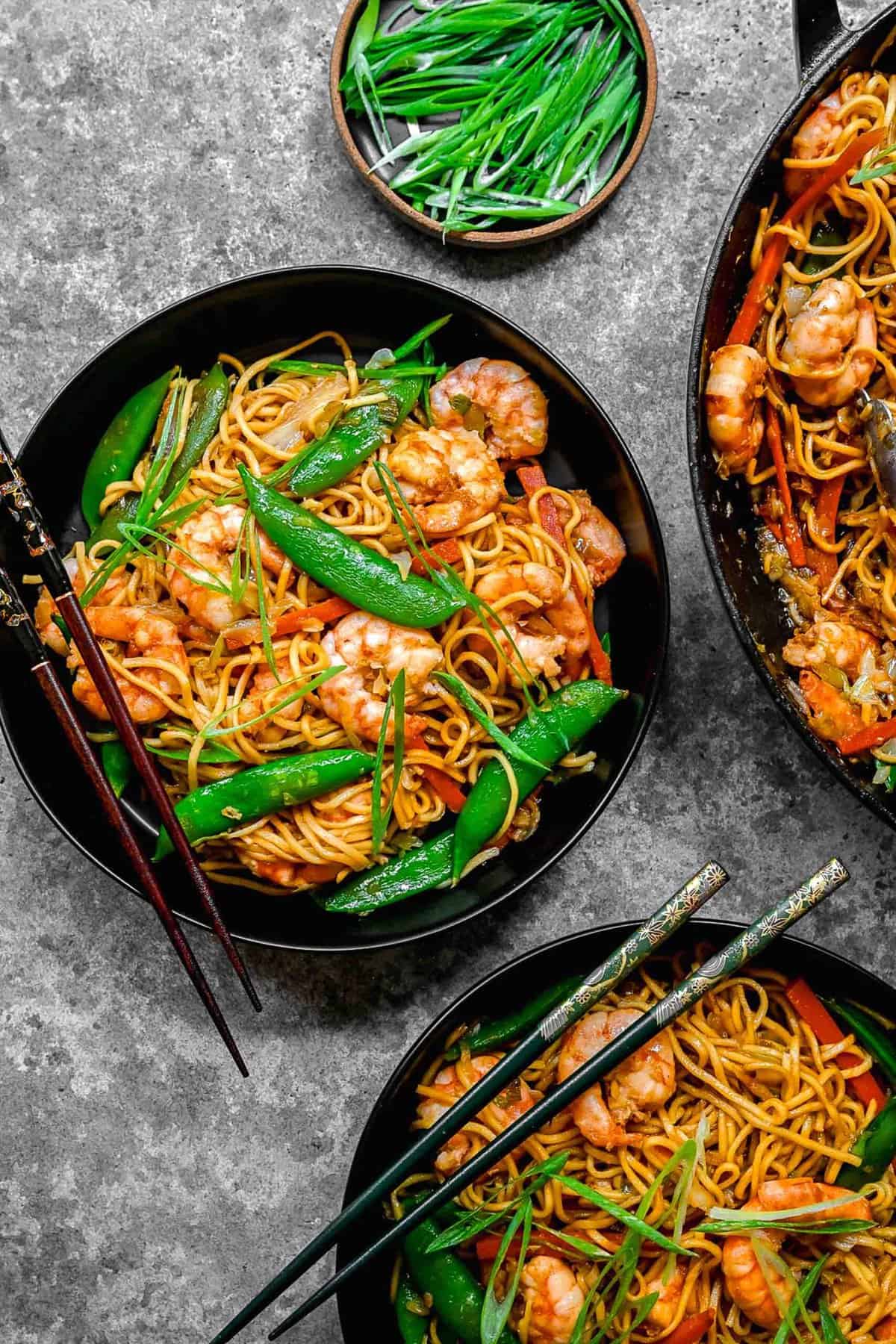
Easy Shrimp Chow Mein Recipe
Craving Chinese but tired of spending the money and feeling a little yuck after ordering takeout? This easy, restaurant-quality recipe might just solve all of your problems. An iconic Asian dish, shrimp chow mein is comprised of a delightful blend of pan-fried noodles, succulent shrimp, and crunchy veggies all tossed in a dynamic, savory but ever-so-slightly sweet sauce. The noodles have just the right amount of crispiness to them and the sauce is almost painfully addictive. Zings of ginger, subtle notes of garlic, the subtle sweetness of oyster sauce, and the umami of soy sauce run through the entire dish. You’ll be diving back in for seconds before you know it.
I love how quick and easy (we’re talking just over 30 minutes) this delicious, homemade meal is. Plus, it really is just as good as (if not better than) your favorite takeout joint’s rendition. All of the flavor with none of the pesky preservatives and mystery additives. Plus it’s way easier on your pocketbook. Who could say no to that?
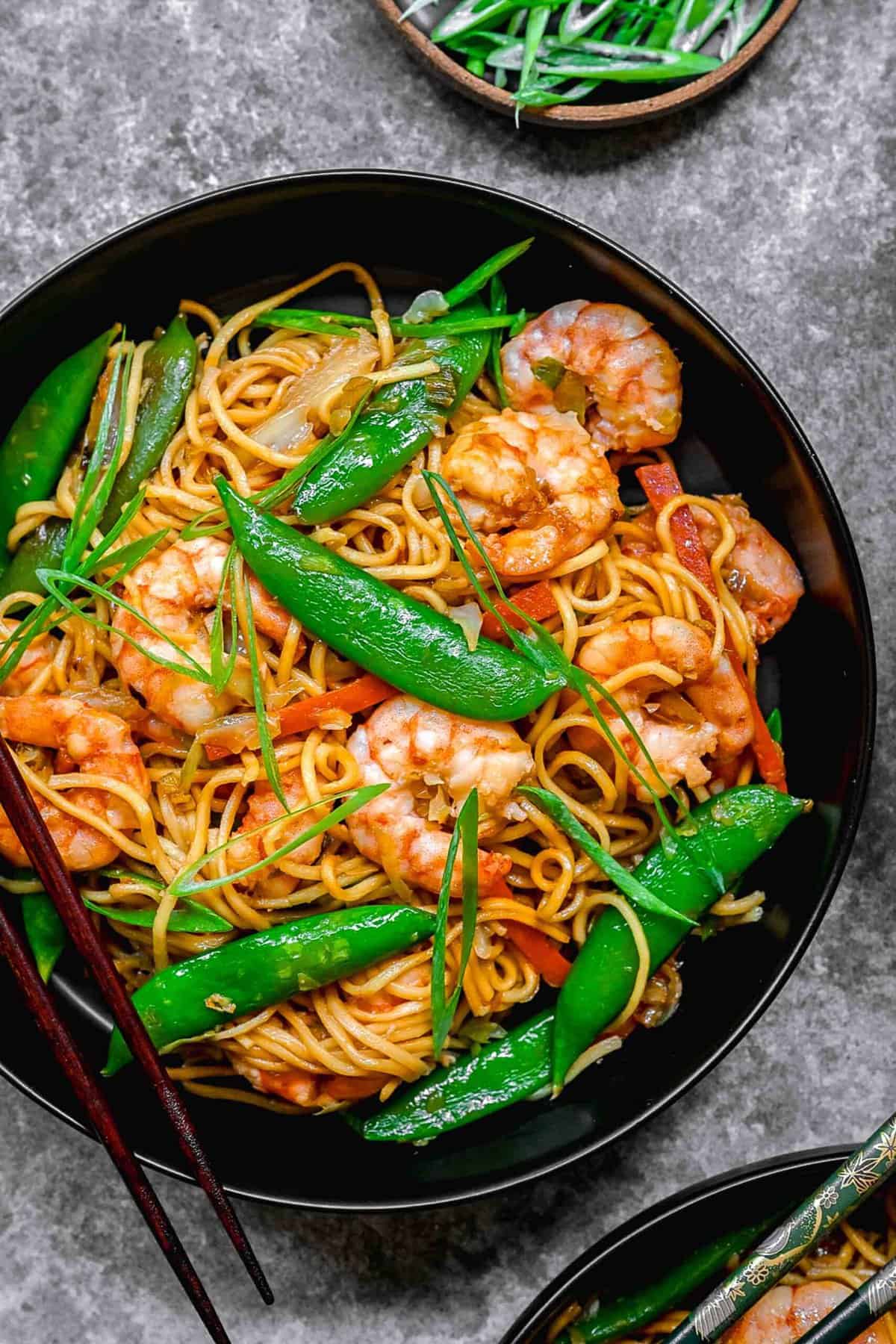
What Is Chow Mein?
Chow Mein, a beloved staple in Chinese cuisine, is a delightful combination of stir-fried noodles, protein (beef, chicken, pork, shrimp, you name it), and an assortment of vegetables, all harmoniously united by a dynamic, savory sauce. The term “chow mein” translates to “fried noodles”. The name refers to the key player in the dish, the perfectly, lightly fried noodles that take on just the slightest crispy texture. Tossed with a wonderfully flavorful, yet not overwhelming sauce and a medley of crisp veggies and some sort of protein, it’s no wonder these noodles have become wildly popular worldwide.
Chow Mein vs Lo Mein
The major distinction between chow mein and lo mein lies in the preparation of the noodle. While both feature noodles in sauce with veggies and, often, a protein, they have distinct characteristics that set them apart.
Chow mein translates to “fried” noodles whereas lo mein translates to “stirred” noodles. The names are fitting. Here’s why.
- Chow mein (“fried noodles”). The noodles in chow mein are boiled and then quickly pan-fried with veggies, some sort of protein, and a sauce. The noodles are not left to cook in the sauce, they are tossed in the pan just enough to be coated in it lightly. The result is flavorful, next-to-crispy noodles.
- Lo mein (“stirred noodles”). The noodles in a typical lo mein dish, on the other hand, are boiled and gently stirred into a luscious sauce along with stir-fried veggies and protein. The noodles are left to simmer for a bit, giving them time to absorb the sauce and take on a softer texture.
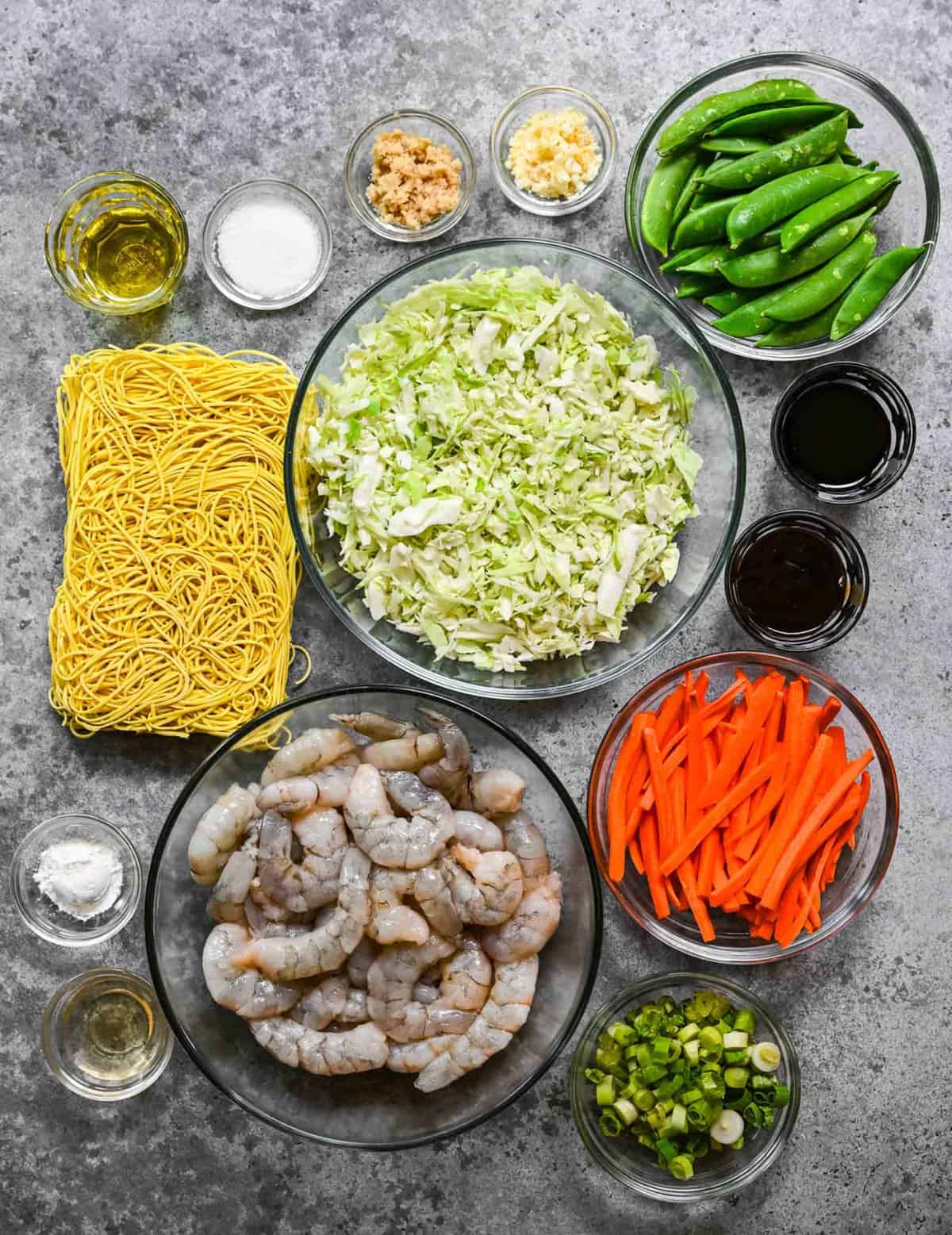
Recipe Ingredients
Here’s what you’ll need to make this flavorful shrimp chow mein recipe. Don’t forget to scroll to the recipe card below for exact quantities.
For the stir fry
- Chow mein noodles – Note that chow mein noodles refer to a dried, thin egg pasta, NOT these crunchy dried noodle pieces, which are often used as a topping in salads and elsewhere. If you can’t find chow mein noodles, angel hair pasta will work almost as well.
- Sesame oil
- Large shrimp – Look for peeled and deveined shrimp.
- Minced garlic
- Grated ginger
- Chopped scallions
- Shredded green cabbage
- Sugar snap peas
- Carrots
For the sauce
- Oyster sauce
- Low-sodium soy sauce – Coconut aminos will also do the trick.
- Rice vinegar
- Sesame oil
- Cornstarch
- Granulated sugar
How To Make Shrimp Chow Mein
You’ll be shocked at how quick and easy it is to make this better-than-takeout chow mein. Here’s a look at how to do it. Be sure to scroll to the recipe card below for more detailed instructions.
- Cook the noodles. Cook the chow mein noodles according to package directions, drain, and set aside.
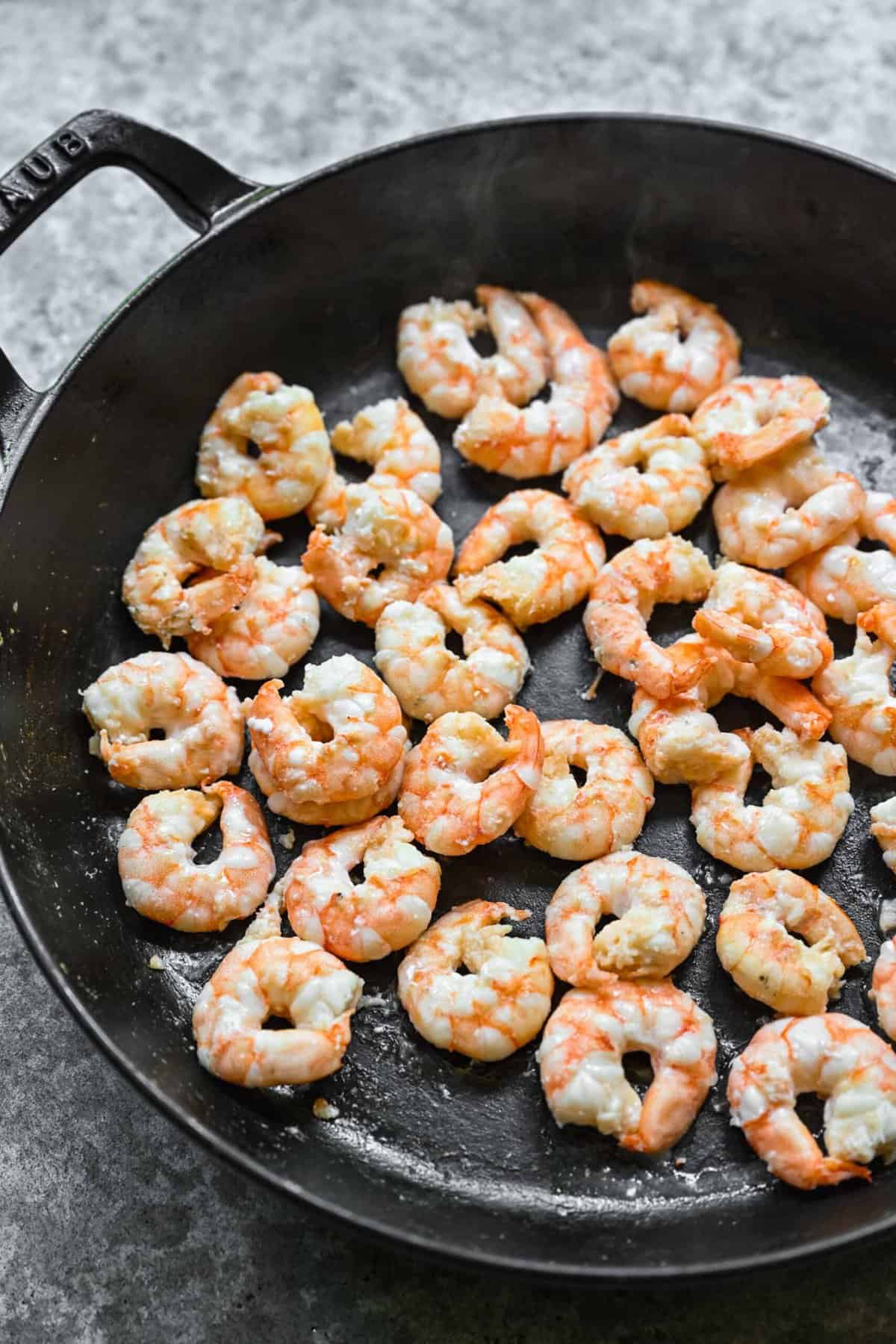
- Stir-fry the shrimp. Heat some sesame oil in a large skillet over medium heat and saute the shrimp until cooked through. Remove the shrimp from the pan and set aside.
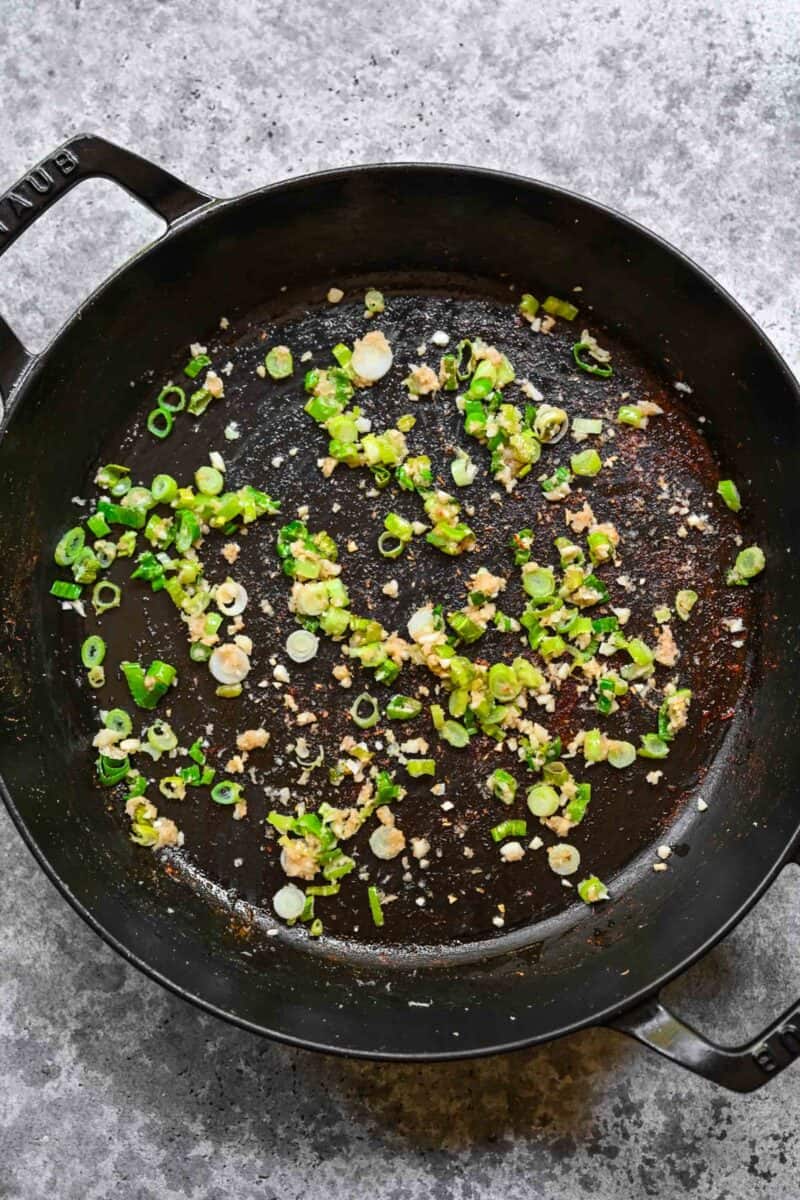
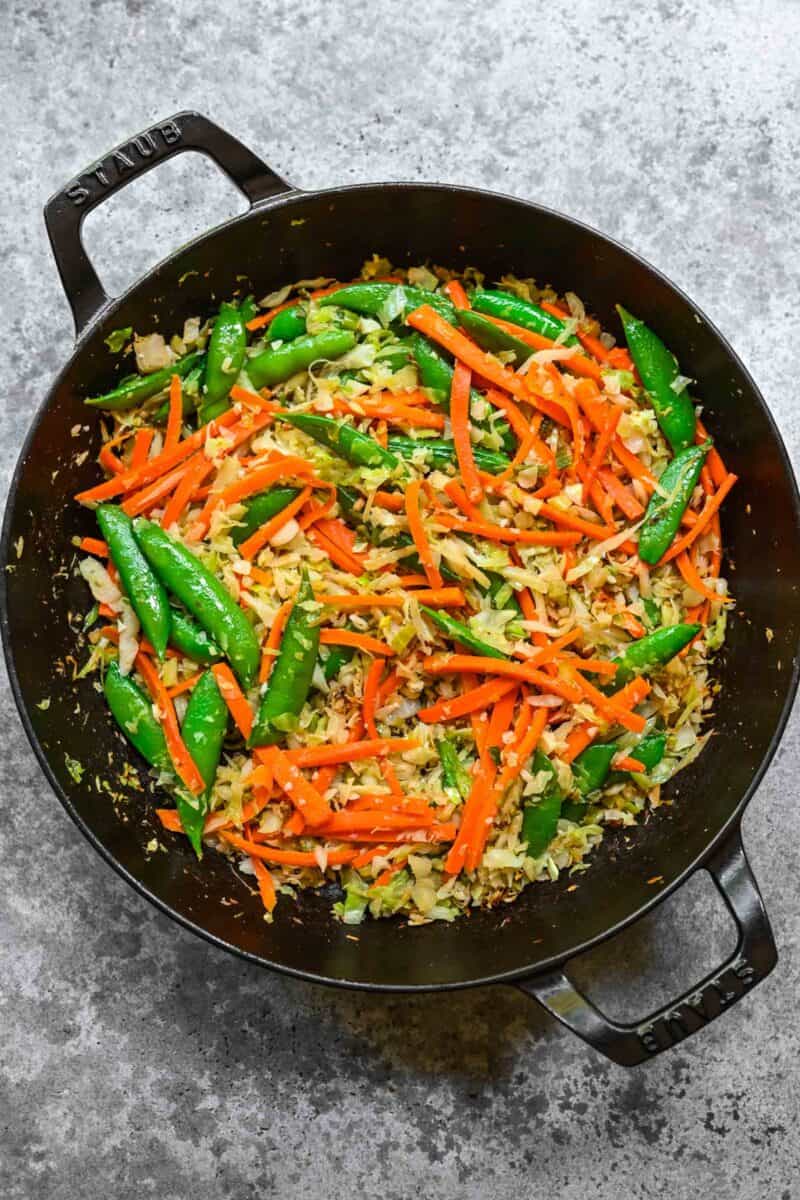
- Saute the veggies. Add the remaining sesame oil to the pan along with the garlic, ginger, and scallions. Sauté for 2-3 minutes. Add in the cabbage, snap peas, and carrots. Saute until tender yet still a little crisp.
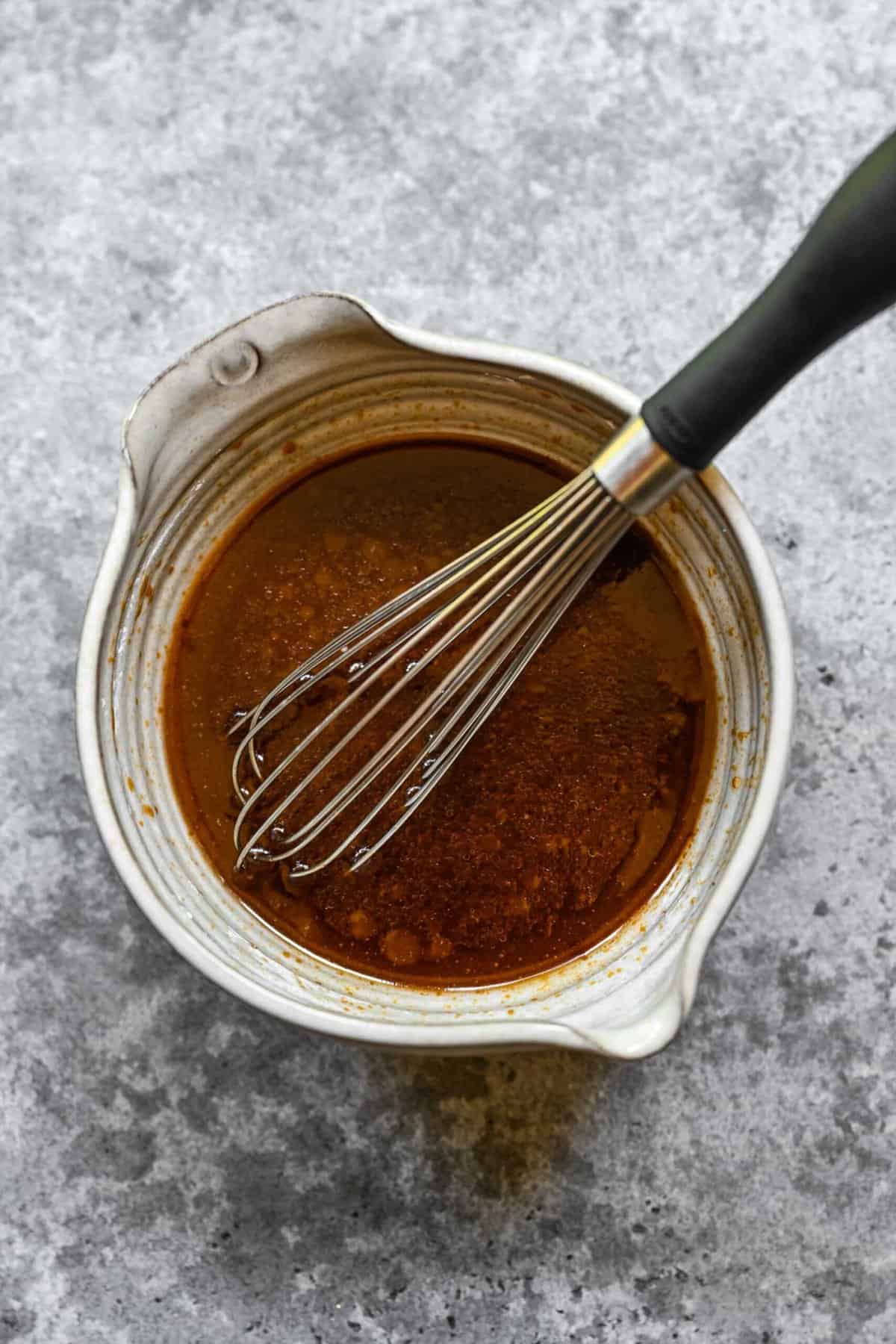
- Make the sauce. Whisk together all ingredients for the sauce.
- Put it all together. Add the shrimp, cooked noodles, and sauce to the pan with the veggies and saute until heated through.
- Serve. Serve right away garnished with scallions.
Recipe Tips & Variations
I am so excited for you to try this shrimp chow mein recipe but, before you dive in, I highly suggest that you put your study cap on and check out the following tips and tricks. They will help you get some of the best noodles you’ve ever tasted. I even threw in some fun variations that will help you make this recipe your own.
- Prep ahead. Once you start adding ingredients to the skillet, everything will move very quickly. It is highly beneficial to slice and dice everything ahead of time and put it within arm’s reach of the stove before you even turn on the heat.
- Al dente. It is important not to overcook the noodles here. You want them to be just al dente otherwise they will turn into a soggy mess when you attempt to fry them in the pan.
- Keep it moving. To ensure that everything cooks evenly, doesn’t burn, and doesn’t turn into a sticky mess, it’s important to stir constantly from the moment you add the garlic, ginger, and scallions to the pan to the moment you remove the finished dish from the heat.
- Don’t overcook the shrimp. Shrimp cook quickly, so keep an eye on them. Once they curl slightly and become opaque, remove them from the skillet.
- Add some spice. Feel free to add a few drops of Sriracha to the sauce or a smattering of red pepper flakes if you’re in the mood for a little heat.
- Play with protein. Shrimp not quite your style? Go ahead and use a different seafood (scallops would be great) or even thinly sliced chicken or beef. Vegetarian? Swap the shrimp for tofu or tempeh and add more veggies to the mix.
- About the veggies. I used carrots, cabbage, and sugar snap peas but pick your favorites. Mushrooms and/or bell peppers would also be delicious.
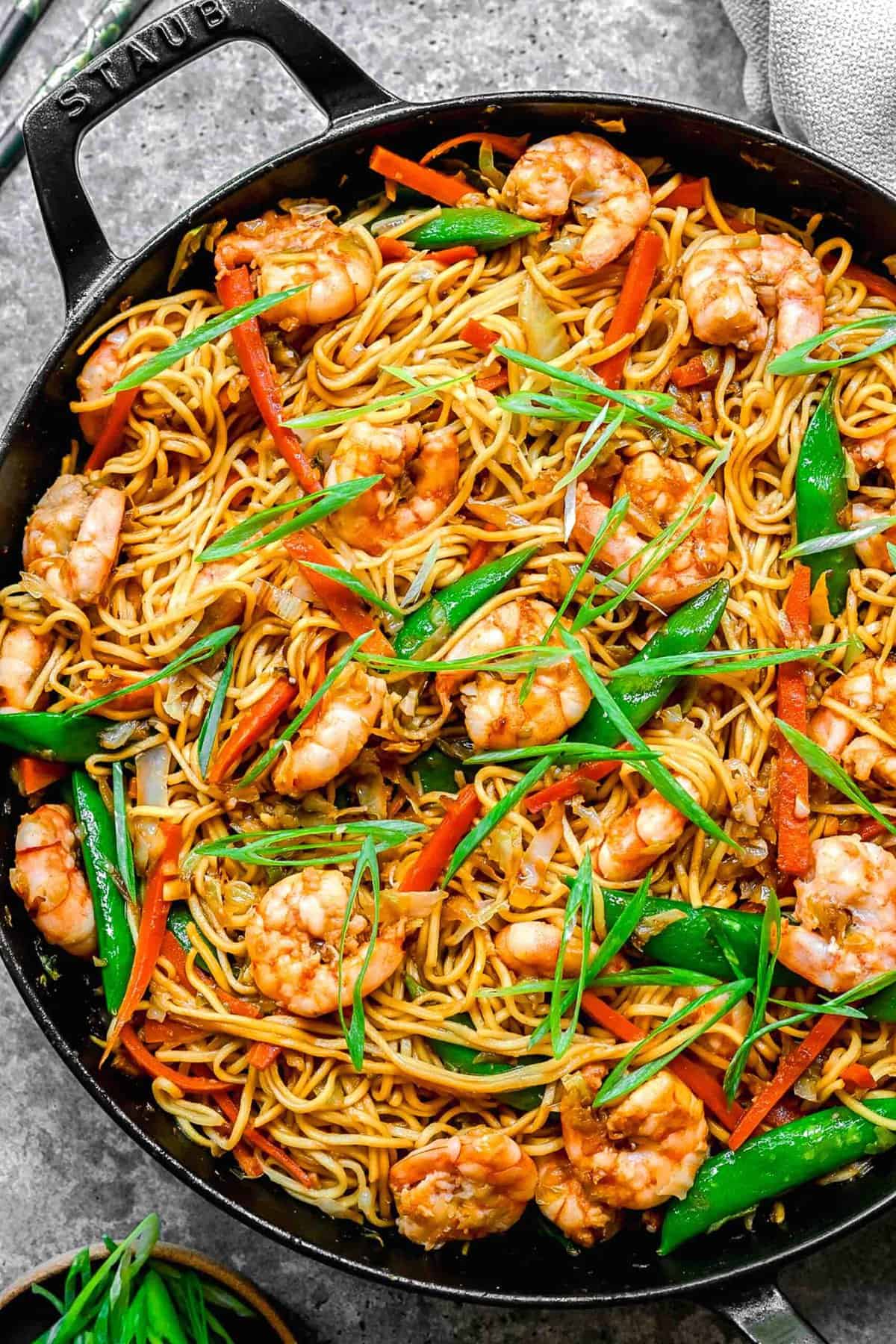
Serving Suggestions
Full of veggies, protein, and some good ol’ fashioned carbohydrates, this chow mein really is a meal in and of itself. That being said, it does love company. Entice your taste buds with one (or several) of these other Asian-inspired dishes.
- Veggies. Add a little freshness to your meal with cold garlic and soy green beans or this
Smashed Asian Cucumber Salad - Steamed buns. I love sopping up any extra sauce left behind by these noodles with Chinese steamed buns or these delicious Bao Buns.
- Soup. Pair this delectable stir-fry with a bowl of hot and sour soup or egg drop soup for a heartwarming meal.
- With a fun appetizer. Serve shrimp low mein as the main following a delicious Asian-inspired starter. I have been loving these Crab Rangoon, Shrimp Shumai, and these Chinese Curry Pockets lately.
How To Store Leftover Chow Mein
- Refrigerator. Allow the chow mein to cool completely before sealing it in an airtight container and storing it in the refrigerator. It will stay good for up to 4 days.
- Freezer. Once the stir-fry has cooled to room temperature, seal any leftovers in a freezer-safe airtight container. Store it in the freezer for up to 3 months. Allow the chow mein to thaw in the refrigerator before reheating.
- To reheat. Heat a bit of sesame oil in a skillet over medium heat. Add the desired portion to the pan and sauté until everything is heated through. You can also pop a portion in the microwave and microwave in 30-second intervals (stirring between each) until heated through.
More Asian-Inspired Recipes
Feeling inspired to create more delicious, Asian-inspired meals? Here are some of my favorites. Let me know what you think!
- Asian Beef and Broccoli Noodles
- Chicken Bao Buns
- Moo Shu Pork
- Kimchi Ramen
- Bo Luc Lac (Vietnamese Shaking Beef)
- Chicken Katsu Curry
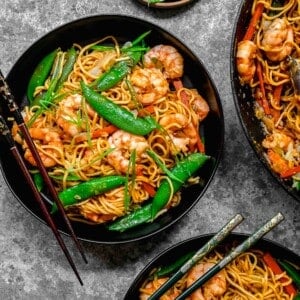
Shrimp Chow Mein
Equipment
Ingredients
For the stir fry
- 12 ounces (340 g) chow mein noodles, cooked according to package directions
- 3 tablespoons sesame oil, divided
- 1 ½ pound large shrimp, peeled and deveined
- 1 tablespoon minced garlic
- 1 tablespoon grated ginger
- ½ cup finely chopped scallions + more for garnish
- 3 cups (210 g) shredded green cabbage
- 1 ½ cups (147 g) sugar snap peas
- 2 large carrots, julienned
For the sauce
- ⅓ cup (77 g) oyster sauce
- ⅓ cup (79 ml) low sodium soy sauce
- 2 tablespoons rice vinegar
- ¼ cup (59 ml) sesame oil
- 2 teaspoon cornstarch
- 1 tablespoon granulated sugar
Instructions
- Cook chow mein noodles according to package directions, drain and set aside.12 ounces (340 g) chow mein noodles
- Heat 2 tablespoons of sesame oil in a large skillet over medium heat. Add the shrimp and sauté for 4-5 minutes, until pink and cooked through.3 tablespoons sesame oil, 1 1/2 pound large shrimp
- Remove the shrimp from the skillet and set aside.
- Add in the remaining tablespoon of sesame oil and the garlic, ginger and scallions. Sauté for 2-3 minutes, until softened. Add in the cabbage, snap peas and carrots and continue cooking for 6-8 minutes, until the vegetables are crisp-tender.1 tablespoon minced garlic, 1 tablespoon grated ginger, ½ cup finely chopped scallions + more for garnish, 3 cups (210 g) shredded green cabbage, 1 1/2 cups (147 g) sugar snap peas, 2 large carrots
- Meanwhile, whisk together all ingredients for the sauce.⅓ cup (77 g) oyster sauce, ⅓ cup (79 ml) low sodium soy sauce, 2 tablespoons rice vinegar, ¼ cup (59 ml) sesame oil, 2 teaspoon cornstarch, 1 tablespoon granulated sugar
- Once the vegetables are done, add back in the shrimp, the cooked noodles and the sauce. Toss well to coat, cooking for another 2 minutes to heat through.
- Remove from heat and serve immediately with more scallions for garnish.

